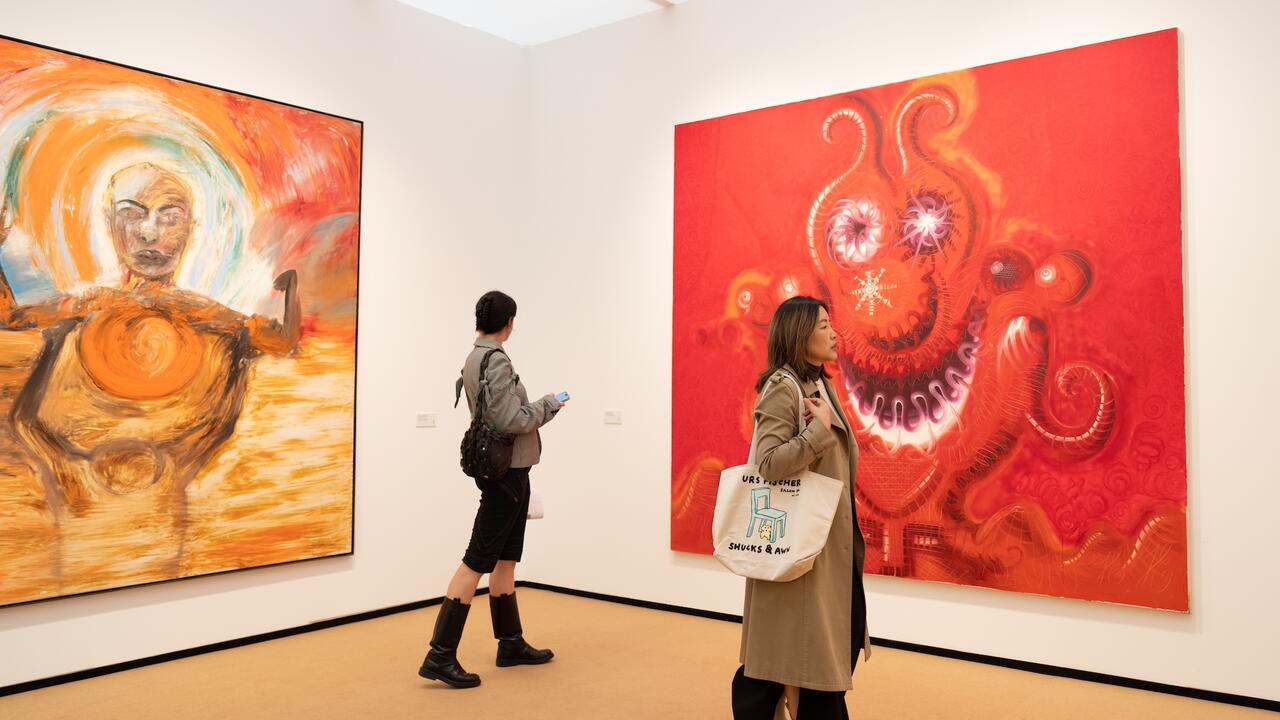Reinhard Mucha
Sprüth Magers, Berlin, Germany
Sprüth Magers, Berlin, Germany

Reinhard Mucha’s exhibition at Sprüth Magers – his first with the gallery, and his first solo show in Berlin since 1996 – was a time capsule of its own making. Neither time nor exhibition making are simply linear affairs in Mucha’s work. An exhibition within an exhibition, ‘Frankfurter Block. Arbeiten am Hohlkasten 1981–2014’ (Frankfurt Block. Working the Box-Girder 1981–2014), included works whose complexly coded titles give multiple dates indicating when the pieces were first made (without brackets), or reworked (in square brackets), or the original dates are given of existing works incorporated (in round brackets). If this sounds complicated, it is, and it goes some way to suggest the precise calibration – if not pedantry – of Mucha’s working process. In an exhibition of this ambitious scale, the calibration was multiplied to almost manic proportions, as reworkings of reworkings of reworkings plotted out over the last 33 years of the artist’s professional life.
Many works refer to and incorporate materials from Mucha’s own past: childhood photographs, his graduation certificate from the Dusseldorf Academy and a photograph of his teacher, Klaus Rinke, floorboards from his long-term Dusseldorf studio, sleds and blankets referring to Joseph Beuys, and, indeed, an entire exhibition from his youth. This becomes most convoluted in a work whose title says it all: Untitled (Head in Sand – Kunsthalle Bielefeld – Created for the exhibition: ‘Ars Viva – Sculptures and Installations by prizewinners selected by the Cultural Committee of German Business within the Federation of German Industries BDI e.V’ – 1981), [2012], 1982. Phew! Picking apart these dense coordinates, the work reveals itself to have been first exhibited in a travelling show of young German artists in 1982, which itself re-used a work from the Ars Viva show the year before. All of this was then exhibited, with various amendments and additions, in Frankfurt’s Galerie Grässlin in 2012. This totality now became part of Frankfurter Block [2014], 2012, an assemblage in which the entire Frankfurt exhibition was recreated within a one-to-one scale plasterboard replica of Galerie Grässlin.
To call Frankfurter Block a ‘plasterboard replica’ does it a disservice, however. As ever with Mucha, it was an exquisitely rendered structure: regularly panelled plasterboard walls on the outside were edged with moulded wooden skirting board, while the interior walls were lined with linen and the floor carpeted in grey. Mucha’s carefully chosen material repertoire speaks of mid-century museums with dim lighting, display pedestals and dust-free, felt-lined vitrines. But the sleek wooden surfaces and prolific reflections of many sheets of glass also suggest the bureaucratic boardrooms in which the post-war German economic miracle was orchestrated. Jokes occurred in materials too: the legs of three authoritative-looking locked metal and glass vitrines (containing stacks of unopened envelopes all addressed to Mucha) were raised on little wooden footstools in a moment of comic inappropriateness.
The myriad references and particularities sound deadening when spelled out in words, but the materials themselves resonated with an intensity that provided a surprising counterpart to the work’s snail’s pace deliberation, cryptic self-reflexivity and historical negotiation. The exhibition was a theatre of staged views of calibrated surface alignments and well-placed hardware, proffering many side-on glimpses of Mucha’s signature felt-lined aluminium box-girder constructions.
Time is the crux of Mucha’s work. There is no quick fix to be had: these pieces demand that the viewer spend as long with them as did their maker. While Mucha’s old-fashioned materials (Cut-out coupons! Posted letters! Black and white videos!) and his craftsman’s approach create a temporal vacuum, the works’ slow elaboration suggests persistence and continuity. These re-worked pieces are like ideas that can’t be skimmed over quickly, that won’t go away. Everything is relevant enough to be kept and used again. In this exhibition, Mucha drew a three-decade arc between himself as a 30-year-old artist, seen at the time as the successor to Joseph Beuys, and his current, older self. The powerful result was surprisingly devoid of nostalgia. The passing of time appears as a gathering of density and scale to be relished, not regretted.






















